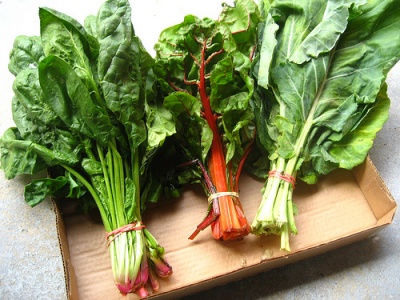Chlorophyll
| See Also | Food Supplements |
|---|
Chlorophyll is the green pigment of plants found in the chloroplast compartment of plant cells. By the process of photosynthesis, electromagnetic energy (light) is converted into chemical energy in the chloroplast. In order for this reaction to occur, the chlorophyll molecule is essential. Natural chlorophyll found in green plants is fat soluble, while the chlorophyll products found in health stores contain water-soluble chlorophyll. Water-soluble chlorophyll is produced from the natural chlorophyll molecule which is altered chemically.[1]
Contents
Food sources
Chlorophyll is found in grasses, leaves and green-leafy vegetables. The darker green the plant, the more chlorophyll that it contains. The foods that are believed to have the highest amount of chlorophyll include - asparagus, bell peppers, broccoli, Brussels sprouts, green cabbage, celery, collard greens, green beans, green peas, kale, leeks, green olives, parsley, romaine lettuce, sea vegetables, spinach, Swiss chard, and turnip greens.
- Chlorophyll is also available in herbs such as Alfalfa (Medicago sativa).
Considerations
- The structure of chlorophyll is quite similar to that of red blood cells. A basic difference is that red blood cells contain an iron atom at the center of their structure (called a porphyrin ring), whereas chlorophyll contains magnesium. Chlorophyll is also high in calcium.
- Impact of Cooking: When green vegetables are cooked and/or exposed to acid the magnesium gets removed and is replaced by an atom of hydrogen. With this one simple change, the color of the vegetable changes from bright green to olive-gray.
- Prolonged cooking decreases the amount of available chlorophyll.
- Short steaming does not appear to decrease the availability or amount of chlorophyll.
Uses
The potential uses for chlorophyll include:
- Water-soluble chlorophyll is used medically to help control body, fecal, and urinary odor.[1]
- increases the quantity and quality of red blood cells
- assists with the chelation of heavy metals
- immune support
- pancreatitis
- acid base balance
- increases bone, tooth and nail strength
- natural body cleansers
Prescribing considerations
- Food: 1/2 to 1 cup a day of vegetables high in chlorophyll
- Supplementation: 300 mg a day, in divided doses for 3 to 4 months or 25 drops of liquid chlorophyll in water once or twice a day.
Safety
Chlorophyll is generally regarded as safe.
References
- ↑ 1.0 1.1 Murray, MT (1996) Encyclopedia of Nutritional Supplements, The Essential Guide for Improving Your Health Naturally, Prima Publishing.
